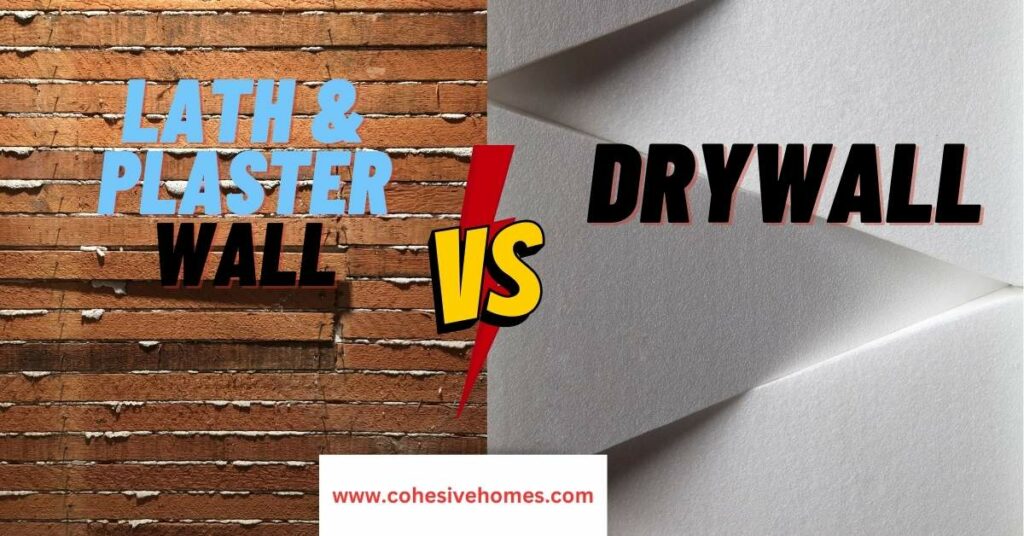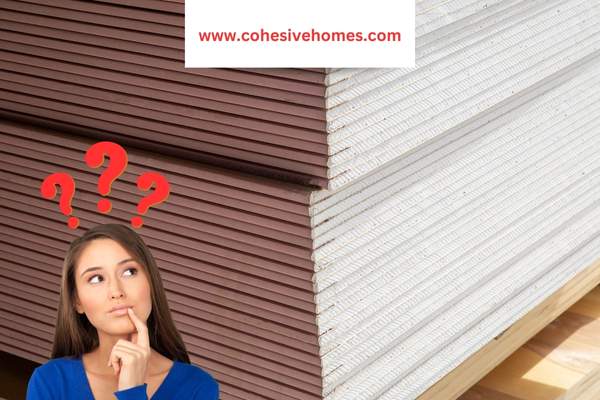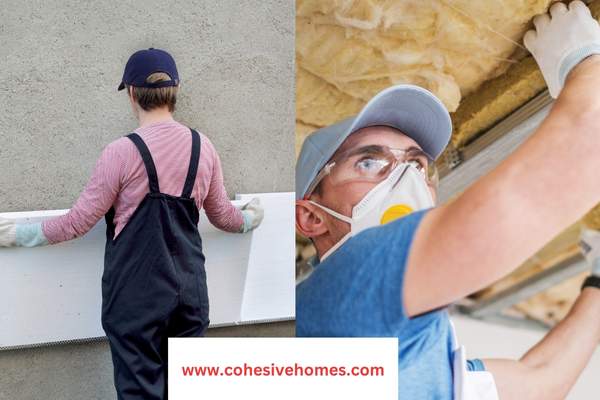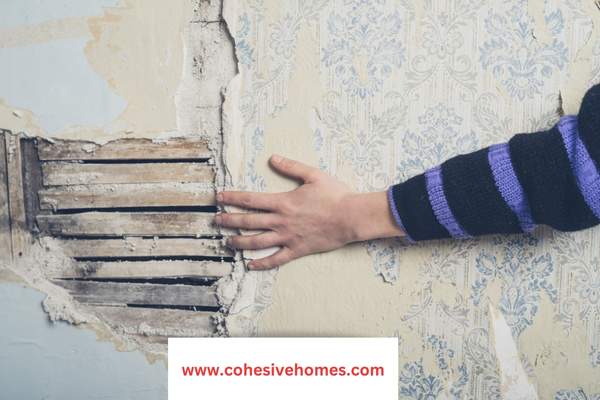
When choosing between drywall vs lath and plaster for your home’s walls, it’s essential to consider factors like the desired aesthetic, acoustics, and budget.
Drywall is a popular and cost-effective option, as it’s easy to install, repair, and offers good fire resistance.
However, if superior soundproofing and insulation are priorities, lath and plaster may be a better choice, despite being more expensive due to labor-intensive installation and higher material costs.
Ultimately, the decision depends on individual preferences and priorities.
Lath and plaster, while more time-consuming and difficult to install, provide a thicker, more durable, and more flexible finish that can be ideal for older homes or homes with unique architectural features.
In most cases, drywall is the preferred choice for new construction, while lath and plaster is often used to preserve the original character of older homes.
What Is a Lath and Plaster?

A lath and plaster wall is an older construction method used to build interior walls and ceilings.
It consists of thin wooden strips (lath) attached to a wooden frame and then coated with several layers of wet plaster.
The plaster hardens as it dries, forming a solid surface.
The final finish can be sanded smooth and painted or left as is, providing a natural, textured appearance.
This walls are often used in older homes or homes with unique architectural features to preserve the original character and appearance of the space.
However, the installation process is time-consuming and labor-intensive, and the walls can be more sensitive to moisture than modern drywall.
What Is a Drywalls?

Drywall, also known as gypsum board, is a common building material used to construct interior walls and ceilings.
It consists of a gypsum core sandwiched between two sheets of heavy paper.
The panels are cut to size, attached to wooden studs or joists, and then finished with joint compound and paint.
The process of installing drywall is quicker and less labor-intensive than lath and plaster, and it is a cost-effective alternative for new construction projects.
Drywall is smooth and easy to paint, but lacks natural appearance and acoustic qualities of lath and plaster.
Lath and Plaster vs Drywall
Cost Comparison

Lath and plaster is generally more expensive than drywall.
Lath and plaster is pricier due to labor-intensive installation and higher material costs, including wood lath and several plaster coats.
Drywall is quicker and easier to install, which reduces labor costs, and its materials are less expensive.
Lath and plaster costs 25-50% more than drywall, but varies based on project size, labor costs, and materials.
Thickness

Lath and plaster walls are typically thicker than drywall walls.
A typical lath and plaster wall may have a total thickness of 1-1.5 inches, including the wooden lath and multiple coats of plaster.
In comparison, standard drywall has a thickness of 1/2 inch or 5/8 inch.
Thicker drywall options available, but still not as thick as lath and plaster walls.
The thickness of lath and plaster walls provides improved insulation and soundproofing compared to drywall, but it also increases the cost of the project and the amount of space taken up by the walls.
Repair

Repairing lath and plaster is difficult; it requires a skilled worker to match texture. Moisture damage makes repairs challenging.
Drywall repairs are straightforward and can be done by homeowners or handymen. Holes and dents are filled with joint compound, sanded, and painted.
Drywall is less susceptible to moisture damage, reducing the need for repairs. Lath and plaster have a natural look and better soundproofing, but drywall is more practical.
Soundproofing and Insulation

Lath and plaster provides better soundproofing and insulation than drywall.
Lath and plaster absorbs sound and reduces noise transmission and plaster creates an airtight seal for better insulation.
Drywall can still provide good soundproofing and insulation with soundproofing materials. Thicker drywall options offer better insulation.
In short, Lath and plaster is superior, but drywall can perform well with soundproofing materials or thicker options.

The benefits and drawbacks of Lath & Plaster vs Drywall are listed below

Lath & Plaster
| BENEFITS |
| Durability: Lath and plaster is strong and durable, ideal for older homes and buildings with unique features. |
| Flexibility: Lath and plaster can be molded into complex shapes for intricate details and unique designs. |
| Natural Finish: Lath and plaster adds character and warmth with its natural, textured finish that can be painted or left as is. |
| Improved Acoustics: Lath and plaster walls improve room acoustics, ideal for home theaters or music rooms. |
| DRAWBACKS |
| Cost: Lath and plaster is more expensive than drywall due to the higher cost of materials and the time-consuming installation process. |
| Difficult to Install: Installing lath and plaster is a labor-intensive and time-consuming process that requires skilled workers and specialized tools. |
| Difficult to Repair: Lath and plaster can be difficult to repair if it is damaged, as it requires a skilled worker to match the existing finish and make repairs. |
| Moisture Sensitivity: Lath and plaster is more sensitive to moisture than drywall, making it more susceptible to mold and mildew growth. |
Drywalls
| BENEFITS |
| Cost-Effective: Drywall is less expensive than lath and plaster due to easier installation and lower material costs. |
| Easy to Install: Drywall is a simpler material to install than lath and plaster, making it a popular choice for new construction projects. |
| Easy to Repair: Drywall is practical as it can be easily repaired with minimal fuss. |
| Improved Fire Resistance: Drywall is a safer choice than lath and plaster, providing better fire resistance. |
| DRAWBACKS |
| Limited Design Options: Drywall provides limited design options compared to lath and plaster, as it cannot be molded into complex shapes or curves. |
| Poor Acoustics: Drywall does not provide the same level of soundproofing as lath and plaster, making it less ideal for use in home theaters or music rooms. |
| Lack of Character: Drywall can have a flat and uninspiring appearance, lacking the character and warmth provided by lath and plaster. |
| Susceptibility to Damage: Drywall is more susceptible to damage from impact, such as holes or dents, compared to the more durable lath and plaster. |
How to Tell Whether Your Walls Are Lath & Plaster or Drywall in 4 Simple Ways

- Visual inspection: Look at the surface of the wall. Drywall has a smooth, uniform surface, while lath and plaster have a textured, irregular surface.
- Tap the wall: Drywall will have a dull, solid sound when tapped, while lath and plaster will have a hollow, echoing sound.
- Look for electrical outlets: Drywall has electrical outlets that are flush with the wall, while lath and plaster has electrical outlets that are set back into the wall.
- Check the age of the building: lath and plaster was commonly used in homes built before the 1950s, while drywall became more popular in the mid-20th century.
Note : Consult a professional to determine the wall structure in your home as these recommendations may not always be accurate.
Is lath & plaster stronger than drywall?

Walls made of plaster and lath are often more impact-resistant than walls made of drywall.
The ability of the structure to evenly transmit force throughout the wall and absorb impact reduces the likelihood of a lath and plaster wall cracking or breaking.
Lath and plaster are more prone to moisture damage than drywall, which is also simpler to fix.
Lath and plaster are more combustible and can easily catch fire in the event of a fire, but drywall includes a fire-resistant core that aids in slowing the spread of fire.
In short, drywall is easier to repair and has better fire resistance than lath and plaster walls, but lath and plaster walls have better impact resistance.
Conclusion

Both lath and plaster and drywall have their own unique advantages and disadvantages.
Lath and plaster walls offer improved impact resistance and soundproofing but are more difficult to repair and less fire-resistant.
Drywall is easier to repair, has a fire-resistant core, and is more commonly used in modern construction.
Choosing between lath and plaster vs drywall depends on needs and factors such as cost, appearance, soundproofing, insulation, fire resistance, and repair ease.
FAQS
Q: What is the difference between drywall and lath and plaster?
A: Drywall, also known as plasterboard or gypsum board, is a panel made of gypsum plaster pressed between two thick sheets of paper. On the other hand, lath and plaster is a construction technique where wooden laths are nailed to the wall studs and then several layers of plaster are applied over the laths.
Q: Which one should I use, drywall or lath and plaster?
A: The choice between drywall and lath and plaster depends on various factors. Drywall is easier and faster to install, making it suitable for new constructions and remodeling projects. Lath and plaster, on the other hand, provides a more traditional and durable finish, making it a better option for older buildings or areas that may require soundproofing or fire resistance.
Q: Can drywall be used to repair plaster walls?
A: Yes, drywall can be used to repair plaster walls. The damaged plaster can be removed and replaced with drywall sheets, which can then be finished with joint compound and painted to match the surrounding plaster.
Q: How many coats of plaster are typically applied in lath and plaster construction?
A: In lath and plaster construction, three coats of plaster are typically applied. The first coat, known as the scratch coat, provides a rough base. The second coat, called the brown coat, is applied over the scratch coat to create a smooth surface. Finally, the third coat, known as the finish coat, is applied to achieve the desired texture and appearance.
Q: Is plaster a suitable wall covering for interior walls?
A: Yes, plaster can be a suitable wall covering for interior walls. It provides a smooth and durable surface that can be finished in various textures, such as smooth, textured, or decorative. Plaster also has good soundproofing properties and can enhance the overall aesthetics of a room.
Q: What are plaster keys?
A: Plaster keys are small indentations or marks made on the wooden laths in lath and plaster construction. These keys help to anchor the plaster and provide a strong bond between the plaster and the lath for better adhesion and durability.
Q: How do you repair plaster walls?
A: To repair plaster walls, you will need to first remove any loose or damaged plaster. Then, you can apply a new coat of joint compound or plaster patching compound to fill in the damaged areas. Once the compound is dry, you can sand it smooth and paint the repaired area to match the surrounding plaster.
Q: Can I use nails instead of screws to attach drywall sheets?
A: It is recommended to use screws instead of nails to attach drywall sheets. Screws provide a stronger and more secure hold, preventing the risk of the drywall coming loose or developing cracks over time. However, nails can be used for temporary installations or where screws are not readily available.
Q: What are the advantages of using drywall over plaster?
A: Drywall offers several advantages over plaster. It is easier and faster to install, requiring fewer coats and drying times. Drywall also doesn’t crack or shrink like plaster, making it more resistant to structural movement. Additionally, drywall is more cost-effective and can be easily repaired or replaced if damaged.
Q: Can I install plaster over drywall?
A: Yes, you can install plaster over drywall. However, it is important to ensure that the drywall is properly prepared and sealed to provide a suitable surface for the plaster. This may involve applying a bonding agent or a base coat before applying the plaster.
